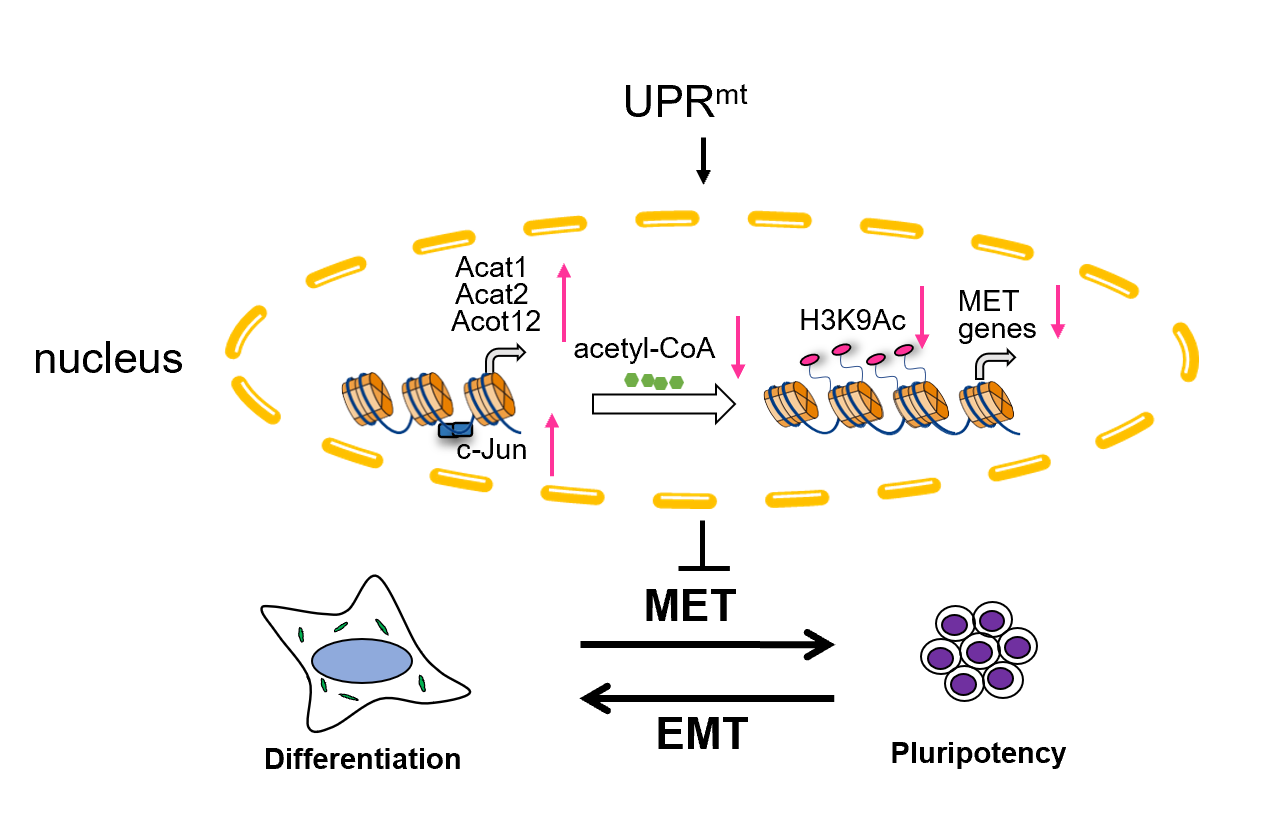Researchers discover a new mode of "mito-meet-to-mitochondria" (mtMET) in the regulation of stem cell fate by mitochondrial stress
Mitochondria play a crucial role in the acquisition of pluripotency and the determination of cell fate. The mitochondrial unfolded protein response (UPRmt) is an important retrograde regulatory pathway from mitochondria to the nucleus. Imbalances in mitochondrial protein homeostasis, elevated ROS, discrepancies in mitochondrial and nuclear gene expression, or mitochondrial dysfunction can all activate UPRmt. Its activation can regulate gene expression, thereby influencing cellular physiological or pathological processes. In nematodes, UPRmt has been shown to delay aging, and its regulatory and activation mechanisms are relatively well understood. However, in mammalian cells, the regulatory mechanisms of UPRmt are more complex, and its role in cell fate determination and development has not yet been reported.
On April 9, 2025, a research team led by LIU Xingguo from the Guangzhou Institutes of Biomedicine and Health, Chinese Academy of Sciences, published a paper titled "The mitochondrial unfolded protein response inhibits pluripotency acquisition and mesenchymal-to-epithelial transition in somatic cell reprogramming" in the journal Nature Metabolism. The team first discovered that UPRmt is transiently activated during the early stages of pluripotency acquisition and gradually diminishes thereafter. They also identified c-Myc as a key factor in the activation of UPRmt. Overexpression of c-Myc significantly increased the expression of Hsp60, a marker of UPRmt, while other transcription factors (Sox2, Klf4, and Oct4) did not exhibit similar effects. Further research revealed that the activation of UPRmt during pluripotency acquisition inhibits the MET process. Notably, UPRmt also plays a regulatory role in MET during early mammalian differentiation and in tumors. Activation of UPRmt can enhance the migration and invasion capabilities of cancer cells.
In terms of the mechanism, the team identified c-Jun, a novel key factor in the UPRmt retrograde signaling pathway, through screening. c-Jun, a proto-oncogene, inhibits the acquisition of pluripotency, and the activation of UPRmt promotes the expression of c-Jun. Through transcriptional regulation, c-Jun upregulates the expression of acetyl-CoA metabolic enzymes, thereby reducing the level of acetyl-CoA. Since acetyl-CoA is closely associated with histone acetylation, the research team further discovered that the activation of UPRmt decreases histone acetylation, particularly the level of H3K9 acetylation (H3K9Ac). The team also found that UPRmt activation reduces the binding of H3K9Ac to the promoter regions of epithelial-related genes (such as E-cadherin and Epcam). This reduction in H3K9Ac levels leads to decreased binding of H3K9Ac to epithelial-related genes, thereby inhibiting their expression and suppressing MET. By supplementing precursors of acetyl-CoA (such as acetate, citrate, and pyruvate), the levels of H3K9Ac can be restored, along with the expression levels of MET-related genes.
In summary, this study is the first to reveal the molecular mechanism by which UPRmt, through c-Jun, reduces acetyl-CoA levels and decreases histone acetylation, thereby inhibiting MET and hindering the acquisition of pluripotency. It elucidates the regulation of MET by mitochondrial pathways. This mitochondrial regulatory mode of MET also exists in early differentiation and tumor contexts, representing a broad biological mechanism. This discovery not only provides a new perspective for understanding how mitochondria retroactively regulate the nucleus and influence cell fate determination but also offers novel insights for future regenerative medicine and potential new targets for cancer therapy.
This study was completed in collaboration with multiple research groups, including Guangzhou Medical University, the Innovation Center for Regenerative Medicine and Health at the Hong Kong Institute of Innovation under the Chinese Academy of Sciences, and The Chinese University of Hong Kong.

Figure. Scheme showing the role of activated UPRmt during the early phase of reprogramming. (Image by Prof. LIU's team)
Contacts:
LIU Xingguo, Ph.D., Principal Investigator;
Guangzhou Institutes of Biomedicine and Health, Chinese Academy of Sciences, Guangzhou, China, 510530.
Email: liu_xingguo@gibh.ac.cn
Attachment Download:
-
ContactLIU Xingguo, Ph.Dliu_xingguo@gibh.ac.cn
-
ReferenceGuangzhou Institutes of Biomedicine and Health, Chinese Academy of Sciences" id="doi" target="_blank" class="xl-r-article">LIU Xingguo
-
Related Article